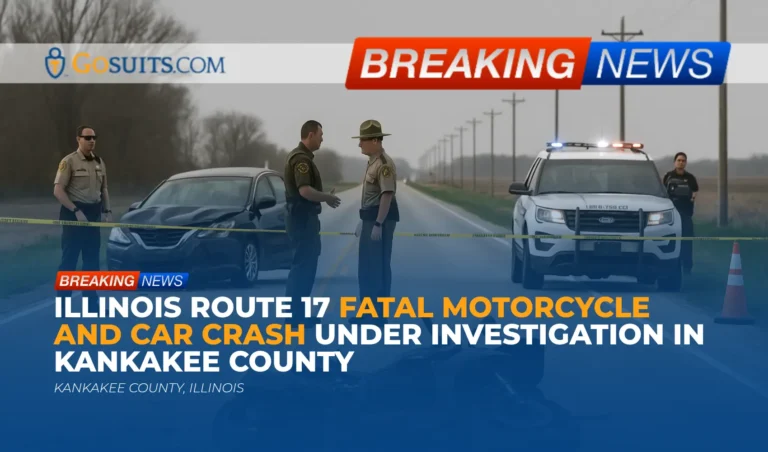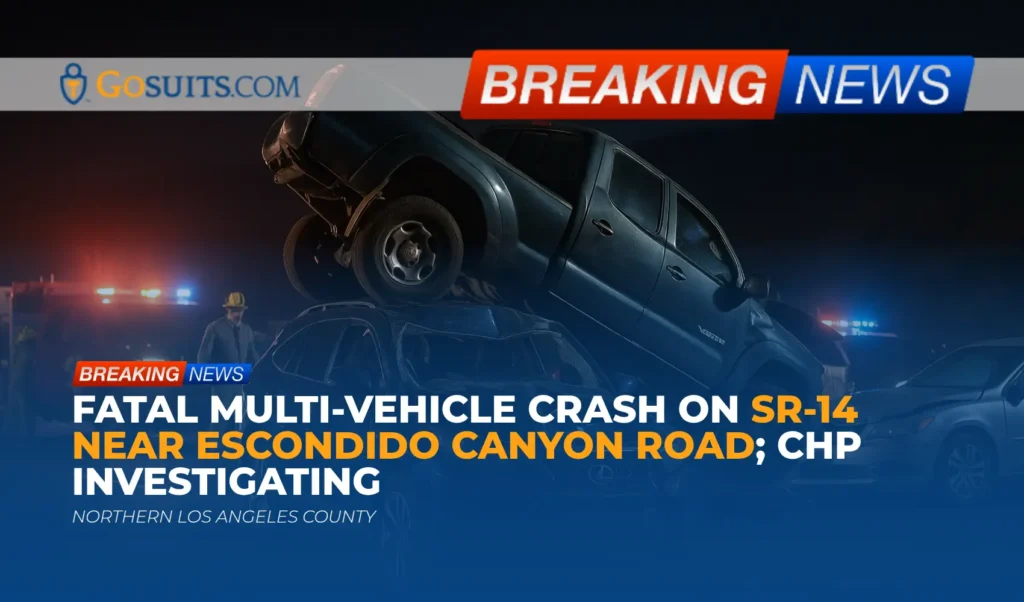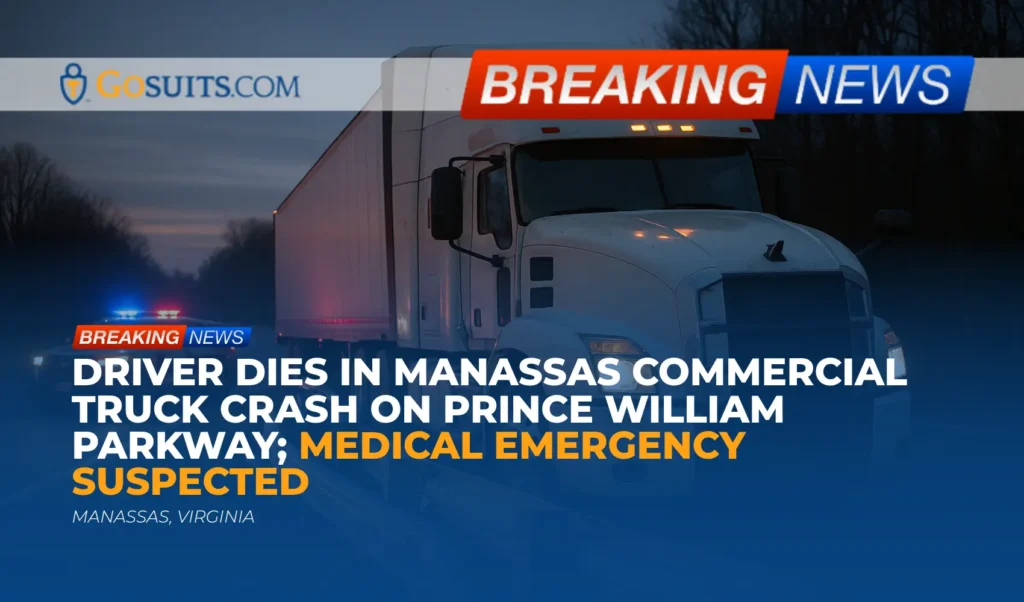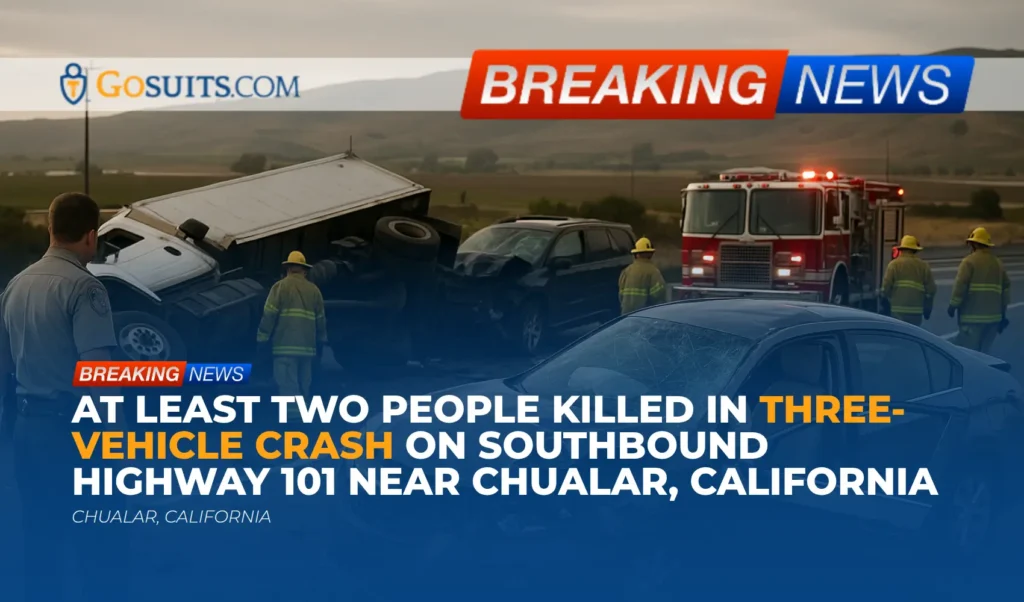- What we know about the crash on Illinois Route 17 in Kankakee County
- Immediate steps families can take after a fatal motorcycle and passenger car collision
- How to obtain official records and documents
- Understanding rights after a fatal traffic collision in Illinois
- Potential civil liability and insurance considerations
- Preserving and investigating evidence
- Safety and context for motorcycle crashes on rural highways
- Working with insurance: cautions and common pitfalls
- Community and public resources
- Grief, support, and practical matters after a sudden loss
- Why taking action matters now
- Commentary from Gosuits Kankakee, Illinois Personal Injury Attorney
What we know about the crash on Illinois Route 17 in Kankakee County
A fatal crash involving a passenger car and a motorcycle occurred on Sunday morning in western Kankakee County. According to the initial public report, Illinois State Police Troop 5 responded at approximately 9:49 a.m. to Illinois Route 17 at South 3120W Road, west of the City of Kankakee. Illinois 17 was closed at the crash site while state police conducted their on-scene investigation. At this time, authorities have not released additional facts about how the collision occurred or information about those involved.
When law enforcement closes a roadway, it usually indicates that troopers and crash reconstruction personnel are documenting and preserving the scene, mapping evidence, and ensuring that emergency responders can work safely. It is normal for official details to be limited during the early stages of an investigation.
Families affected by this crash are likely facing shock and grief while also wondering what to do next. The sections below outline practical steps, how to obtain records, and general legal context that may help during this difficult time.
Immediate steps families can take after a fatal motorcycle and passenger car collision
Stabilize safety and gather essential information
In the hours and days after a crash, needs are immediate and often overwhelming. It can help to focus on a few essentials first.
- Identify the investigating agency and crash number. Here, the investigating agency is the Illinois State Police Troop 5. If available, note the crash report number and the names or badge numbers of any troopers who made contact. This information will be needed to obtain official records later.
- Preserve any personal records. Keep copies of any notifications, hospital or emergency documents, towing receipts, and contact information for witnesses or first responders who reached out.
- Avoid making statements about fault. Emotions run high after a sudden loss. It is best not to speculate publicly or on social media about what happened. Early impressions can be incomplete and could be used out of context later.
Consider support for immediate needs
- Support for dependents. Ensure that children, older family members, or others who relied on the deceased have immediate care, medication, and a stable environment.
- Vehicle and property. Find out where the motorcycle and any other involved vehicles were taken. If possible, ask the towing company to hold them and not release them for salvage or repair until the investigation is complete.
Before contacting insurance
- Speak with an attorney first. Insurance representatives may request recorded statements. What is said to an insurance company can be used later in ways that are not obvious at the time. A consultation can help clarify rights and obligations before any insurer contact.
How to obtain official records and documents
Police crash report and scene documentation
The Illinois State Police maintain reports and many forms of documentation related to a crash. Depending on the stage of the investigation, some records may not be immediately available.
- Illinois State Police website. The ISP site provides information about patrol operations and public records processes. Start at the main site: isp.illinois.gov and the Patrol page: isp.illinois.gov/Patrol.
- FOIA requests. Many records, including crash reports, photographs, and in some cases dash or body camera footage, can be requested under the Illinois Freedom of Information Act. The ISP FOIA portal and instructions are at isp.illinois.gov/Transparency/FOIA. The Illinois FOIA statute is at ilga.gov.
- Crash reconstruction materials. If a traffic crash reconstruction was conducted, those materials can include diagrams, measurements, and analyses. Availability and timing vary. Some items may be released only after the investigation is closed.
Coroner, autopsy, and death certificate
- Coroner’s office. In Illinois, county coroners oversee medicolegal death investigations and autopsies in traffic fatalities. Families can contact the county coroner to ask about timelines for autopsy and toxicology results and about next steps for release of remains. For Kankakee County, contact the coroner’s office for status updates and instructions. If unsure how to reach them, the county’s main government listing can provide the coroner’s office number.
- Death certificate. Certified death certificates are issued through the state vital records system. Information on obtaining death records is available from the Illinois Department of Public Health at dph.illinois.gov/topics-services/birth-death-other-records.
Other records that may help
- 911 audio and CAD logs. Dispatch recordings and computer-aided dispatch logs can sometimes be requested through the relevant agency under FOIA. Response times and initial caller reports can be important context.
- Roadway maintenance and design records. If road signage, sight distance, or maintenance may have played a role, some records may be available through the Illinois Department of Transportation. IDOT’s main site is idot.illinois.gov.
Understanding rights after a fatal traffic collision in Illinois
Illinois law provides civil remedies that may be available after a fatal crash. At a high level, two types of civil claims are often discussed in this context. The information below is general and intended for education.
Wrongful death and survival claims
- Wrongful death. Illinois’ Wrongful Death Act allows a claim for the losses suffered by next of kin due to a death caused by a wrongful act or neglect. This claim is typically brought by the personal representative of the deceased’s estate for the benefit of the next of kin. The Act can be reviewed through the Illinois General Assembly’s statutes database at ilga.gov by searching for 740 ILCS 180.
- Survival claim. The Illinois Survival Act allows certain claims the decedent could have brought if they had lived to survive to the estate. This is commonly cited as 755 ILCS 5/27-6. The Illinois statutes are available at ilga.gov.
Time limits
- General limitations period. Many Illinois personal injury actions must be filed within two years of the incident date, which is codified at 735 ILCS 5/13-202. Wrongful death actions are also generally subject to a two-year period measured from the date of death under the Wrongful Death Act, with certain statutory exceptions. See the Illinois statutes at ilga.gov. Time limits can be affected by case-specific factors, and early review is important.
Comparative negligence in Illinois
- Modified comparative negligence. Illinois uses a modified comparative negligence framework. Damages may be reduced by a claimant’s percentage of fault, and recovery is barred if that percentage is more than 50 percent. This framework is addressed at 735 ILCS 5/2-1116, which can be located through ilga.gov.
Who brings a claim
- Personal representative. Wrongful death claims are brought by the personal representative of the decedent’s estate on behalf of the next of kin. The Illinois Courts website provides general information about court processes and approved statewide forms at illinoiscourts.gov. Local court procedures vary.

Potential civil liability and insurance considerations
Possible at-fault parties
- Other driver. If evidence shows the passenger car driver failed to yield, was inattentive, or otherwise acted negligently, civil liability may rest with that driver.
- Employer of a driver. If a driver was operating a vehicle in the course and scope of employment, the employer may have vicarious responsibility under respondeat superior. This depends on verified facts such as the purpose of the trip and vehicle ownership.
- Vehicle or component issues. In rare cases, evidence may point to a mechanical defect or maintenance issue. This requires careful technical evaluation and documentation before vehicles are altered.
- Roadway conditions. Sight obstructions, signage, or road surface can be relevant. Claims involving public entities have additional procedural requirements and specific time constraints that should be reviewed carefully.
Insurance coverage that may apply
- Liability insurance of the at-fault driver. This is commonly the primary source for bodily injury and wrongful death claims when another motorist is responsible.
- Uninsured or underinsured motorist coverage. Many motorcycle and household automobile policies include UM or UIM coverage, which may apply if the at-fault driver lacks adequate limits. Policy language controls the details.
- Medical payments coverage. Some policies include MedPay coverage that can assist with medical or funeral expenses regardless of fault. Availability varies by policy.
Recorded statements and early settlement talks
- Consult counsel first. Insurance adjusters often request statements and authorizations quickly. These can affect how fault is assigned and what is paid. Speaking with an attorney before giving any statement helps protect rights and ensures that only necessary and appropriate information is shared.
Preserving and investigating evidence
Vehicles and on-board data
- Passenger vehicle event data recorder. Many passenger vehicles have an event data recorder that can capture pre-crash speed, braking, throttle, and other variables. Prompt preservation is important because the vehicle may be repaired, salvaged, or data may be overwritten.
- Motorcycle components and gear. The motorcycle, helmet, and riding gear can hold impact and scrape patterns that help reconstruct mechanics of the crash. They should be stored securely and not altered until a qualified examiner has documented them.
Scene evidence
- Skid marks and debris. In rural highway settings, evidence can be disturbed quickly by traffic and weather. Photographs taken by investigators and any available aerial mapping can be critical.
- Surveillance and dash cameras. Nearby homes, farms, or businesses sometimes have cameras that face the roadway, and some vehicles have dash cameras. Footage can be overwritten in days, so rapid outreach matters.
- 911 audio and dispatch logs. Caller descriptions and response timelines can clarify early facts. These are typically requested through the appropriate agency using FOIA.
Public records processes
- Freedom of Information Act. Illinois FOIA governs access to many government records. The ISP FOIA access page is at isp.illinois.gov/Transparency/FOIA, and the statute itself is at ilga.gov. Some exemptions apply, especially while an investigation is active.
Safety and context for motorcycle crashes on rural highways
Although specific facts about this collision have not been released, it is appropriate to acknowledge broader safety themes that appear in national and state data.
- Motorcyclists are overrepresented in fatal crashes. Federal highway safety data consistently shows that motorcyclists face higher fatality risk per vehicle mile traveled than occupants of passenger vehicles. See the National Highway Traffic Safety Administration’s overview for motorcycles at nhtsa.gov/road-safety/motorcycles.
- Rural road considerations. Rural highways often involve higher operating speeds, fewer controlled intersections, and longer emergency response times. The combination of speed, limited sight distance, and cross traffic can increase crash severity when collisions occur.
- Visibility and gap selection. Research and enforcement experience show that left turns across oncoming motorcycles, gap selection errors, and failure to detect an approaching motorcycle are common factors in multi-vehicle motorcycle crashes. This is why detailed scene mapping, line-of-sight measurements, and headlight or conspicuity assessments can matter in reconstruction.
- Illinois crash data. The Illinois Department of Transportation publishes annual crash facts and statistics that include information on motorcycle fatalities and rural versus urban crash patterns. IDOT’s safety and data resources are available at idot.illinois.gov.
Working with insurance: cautions and common pitfalls
- Recorded statements. Adjusters may request recorded statements soon after a crash. Families are not required to give a recorded statement to another driver’s insurer. Statements can be used to shape fault determinations. It is prudent to consult an attorney before any recorded interview.
- Authorizations. Broad medical or employment authorizations requested by another party’s insurer can open up unrelated private history. Provide only what is strictly necessary after reviewing the request with counsel.
- Early settlement offers. Quick offers sometimes come before a full picture of liability and losses is known. Once accepted and released, claims are typically final. Taking time to understand the scope of damages and coverage can prevent unintended consequences.
- Multiple insurance layers. There can be several applicable policies, including the at-fault driver’s liability coverage, household UM or UIM policies, and any MedPay endorsements. Coordinating benefits and avoiding offset pitfalls takes careful review of policy language.
Community and public resources
- Illinois State Police. General information on patrol operations and how to request public records is available at isp.illinois.gov and isp.illinois.gov/Patrol. FOIA guidance is at isp.illinois.gov/Transparency/FOIA.
- Illinois Department of Transportation. IDOT maintains safety programs and publishes crash statistics, which can help families understand broader roadway trends. Visit idot.illinois.gov.
- Illinois Department of Public Health. For vital records, including certified death certificates, see dph.illinois.gov/topics-services/birth-death-other-records.
- Illinois General Assembly statutes database. The ILCS database provides access to the Wrongful Death Act, the Code of Civil Procedure, and other relevant laws at ilga.gov.
- Illinois Courts. For general court information and statewide forms, including matters related to estate and probate proceedings, visit illinoiscourts.gov.
- NHTSA Motorcycle Safety. National resources on motorcycle safety and crash data are available at nhtsa.gov/road-safety/motorcycles.

Grief, support, and practical matters after a sudden loss
Losing a loved one without warning is devastating. There is no right or wrong way to grieve, and everyone processes loss differently. Some find comfort in reaching out to faith communities, grief counselors, or support groups, while others prefer private time with family and close friends.
- Health guidance on grief. The Centers for Disease Control and Prevention provide general information about grief and loss at cdc.gov/mentalhealth/stress-coping/grief-loss.
- Practical documents. Organize essential documents such as insurance policies, vehicle titles, bank information, and any estate planning documents. Having a single folder or binder can simplify communication with agencies and insurers.
- Memorial planning. Funeral providers often coordinate with the coroner and can advise on timing once the coroner releases remains. Some expenses may be covered in part by insurance benefits or MedPay coverage, depending on policies.
Why taking action matters now
In the aftermath of a serious crash, certain steps are time sensitive. Acting promptly can make a meaningful difference in preserving clarity and options.
- Secure and preserve evidence. Vehicles, especially those stored at towing yards, can be altered or sold. Request that all involved vehicles be preserved in their post-crash condition until inspections are completed. Photographs, nearby camera footage, and 911 audio can be overwritten quickly, sometimes in days.
- Establish a single point of contact. Designate one family representative to communicate with investigators and insurance carriers, which reduces the risk of inconsistent statements and lowers stress for others who are grieving.
- Understand coverage and deadlines. Insurance notifications often have prompt reporting provisions. Statutory filing deadlines apply to civil claims, and some claims against public entities have additional notice requirements. Early review can prevent missed windows.
- Consult before calling insurers. Speaking with an attorney first helps ensure that communications with insurance companies are clear, accurate, and limited to what is necessary. What is said to an insurer can be used later and may affect fault determinations and compensation.
- Document everything. Keep a dated log of calls, letters, emails, and contact names. Save receipts related to towing, memorial services, and other sudden expenses. These records can be important later for insurance and other processes.
Commentary from Gosuits Kankakee, Illinois Personal Injury Attorney
Our thoughts are with the family and friends affected by the collision reported west of Kankakee on Illinois Route 17. Losing a loved one on a Sunday morning, on a familiar rural highway, is a heartbreaking shock. This commentary is provided for educational purposes and general information to help the community understand what typically follows an event like this.
From a civil injury perspective, early questions usually focus on visibility, speed, right of way, and roadway features at the intersection or approach. Rural corridors can combine higher speeds, long sight lines that are deceptive, and cross traffic that creates quick decision points. A thorough investigation often includes mapping the scene, identifying any visual obstructions, evaluating lighting and headlight use, and documenting vehicle damage patterns. Because this collision involved a motorcycle and a passenger vehicle, careful attention to the timing of movements and conspicuity is particularly important. Evidence preservation is time sensitive, especially for vehicle data recorders and any nearby camera footage.
Insurance companies and large corporate insurers are well organized from the first hour after a crash. Their adjusters know the claims process in detail and benefit from early statements and broad authorizations that can limit or control the narrative about fault and losses. Families, on the other hand, are gathering themselves after a sudden loss, often without immediate access to records or an understanding of how different policies interact. That imbalance can lead to pressured decisions, recorded statements given without context, and quick settlement offers that do not reflect the full scope of harm. Taking time to understand rights, available coverages, and the evidence picture helps prevent missteps.
Speaking with a seasoned, skilled attorney for a free consultation before engaging with insurance is a practical way to reduce risk. A consultation can clarify who will request which records, what should be preserved, how to approach insurance communications, and what timelines apply. It also helps set expectations about what information is available early and what usually takes longer, such as autopsy and toxicology findings or reconstruction reports. No one can remove the pain of the loss, but a structured approach to the process can provide steadier footing in the weeks ahead.






